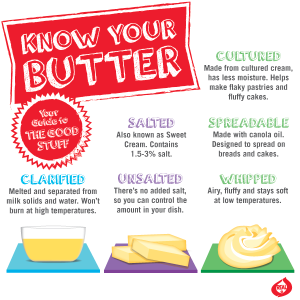Welcome! Are you a subscriber? Click here to receive my weekly newsletter. Thanks for visiting!
This time of year, well anytime in my case, more and more people are baking and cooking. Sharing their culinary generosity with others one tasty bite at a time.
I make cookies, cakes, sauces- you name it. The key for me? Not taking short cuts and using good, whole ingredients. I made the commitment several years ago to eliminate sugar substitutes (all subs for that matter) from our diet. That means we rarely consume sugar and fat free items and I stopped buying margarine. We don’t miss it.
Now I am not saying you should do the same, but what I am saying is moderation and education are the keys to success. I truly think my results are better in the kitchen when I use real butter and dairy.
A few of my favorite recipes that use butter liberally as a star ingredient are: My FAMOUS (in my house) pasta sauce
Did you know?
*The first reference to butter was found on a 4,500 year old limestone tablet illustrating how butter was made
*It is generally believe the word butter originates from the bou-tyron, Greek for “cow cheese”
*In order to traditionally make butter, the cream is separated from fresh whole milk. The cream is then churned by shaking or beating it vigorously until it thickens. The remaining liquid (buttermilk) is then removed. The clustered butter is washed and formed into its solid shape forming a shape of butter.
*Butter is made with 100% natural ingredients—it takes 10.2 L of fresh cow’s milk to make 1 lb of butter.
*Butter is a source of vitamin A, a nutrient important for healthy skin and eyes, as well as strong bones and teeth.
*There are 9 different types of butter: Churned, Sweet, Light, Cultured, Flavored, Blended, Whey, Whipped, and Ghee. Churned butter is traditional, salted butter made by churning pasteurized cream.
*Sweet butter, often labeled unsalted butter, is used in baking and for general cooking and allows for more control of the salt level added to a dish.
*Blended butter is a blend of real butter with liquid oil, such as canola, to make a spread that tastes like butter, yet is soft and easy to spread straight from the refrigerator.
*Where does the color of butter originate? Butter is yellow because of the natural pigment carotene. Carotene comes from the cows’ diet, which consists of hay, silage, grains and cereals, which are converted by our body into vitamin A
*Keep butter refrigerated in its original wrapper as this will help prevent spoilage from exposure to light and art, and also protect butter from picking up the flavor of other foods.
*The world record for butter eating is 7 quarter pound sticks of salted butter in 5 minutes by Donald Lerman.
*Butter has been the basis for naming characters in plays and comic strips, for identifying a specific color or song, as a colloquial term and rule of behavior: for example, “Buttering up” your boss for a raise; “knowing which side your bread is buttered on”: writing a “Bread and butter ‘thank you’ letter.”
*Butter is a natural dairy product made by churning or shaking cream until it reaches a semisolid state. Margarine is made from a single oil, or blend of oils, including animal and vegetable fats.
*Butter, like all foods, can be incorporated into a healthful and moderate diet. Portions should be monitored and it is important to note that one serving of butter is one teaspoon. Using moderate amounts of butter as a spread, ingredient or flavor enhancer can be part of healthy food choices
*2 tablespoons of butter have about 8 grams of fat. About 30 percent is monounsaturated fat, the same fat in olive oil
*India is the largest producer of butter. Ghee, a kind of clarified butter, is an important ingredient in Indian cuisine.
Printed measurements on sticks of butter make measuring easy and convenient. Good-to-know butter equivalents are:
2 cups = 4 sticks = 1 pound
1 cup = 2 sticks = 1/2 pound
1/2 cup = 1 stick = 1/4 pound
1/4 cup = 1/2 stick = 4 tablespoons
This post was brought to you by the Indiana Dairy Council that I am proud to work with on posts such as this. All opinions are my own
